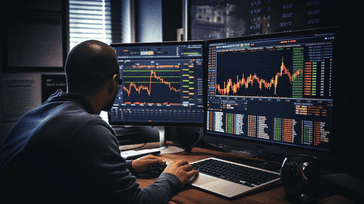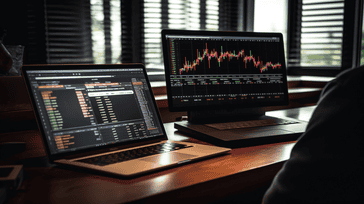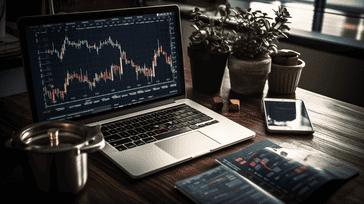Forex Market 101: A Beginner's Guide to Currency Trading

Welcome to our comprehensive beginner's guide to the Forex market, where we cover the basics of currency trading. Whether you're new to trading or looking to expand your knowledge, this guide will equip you with the necessary information to embark on a successful trading journey. The Forex market is a vast and dynamic environment, and this guide aims to provide you with a solid foundation to start trading currencies with confidence. Let's dive in!
Key Takeaways
- The Forex market is a dynamic and ever-changing environment that offers vast opportunities for currency traders.
- Understanding the fundamentals of the Forex market is essential to navigate the world of currency trading successfully.
- The process of getting started with currency trading involves selecting a reliable Forex platform, opening a trading account, and learning the basic trading terminology.
- Choosing the right Forex broker is crucial to enhance your trading experience and safeguard your investments.
- Risk management is a vital aspect of Forex trading, and techniques such as position sizing, stop losses, and risk-reward ratios can help protect your capital and ensure long-term success.
Understanding the Forex Market
The Forex market, also known as the foreign exchange market, is the largest and most liquid financial market in the world. It facilitates the trading of currencies between countries, allowing businesses and individuals to exchange one currency for another for various reasons, including trade, investment, tourism, and speculation.
The Forex market operates 24 hours a day, five days a week, with trading sessions starting in Sydney, then moving to Tokyo, London, and finally New York. Its decentralized structure means that there is no central exchange, and trading is conducted electronically over a network of banks, brokers, and other financial institutions.
The participants in the Forex market can be broadly categorized into three groups: commercial banks, institutional investors, and retail traders. Commercial banks, as the primary market makers, provide liquidity and set exchange rates. Institutional investors, such as hedge funds and pension funds, engage in currency trading as part of their investment strategy, while retail traders access the market through online Forex brokers.
The Factors that Influence Currency Prices
The value of a currency pair in the Forex market is determined by various factors, including economic indicators, geopolitical events, and market sentiment. Some of the most important economic indicators that impact currency prices include interest rates, inflation rates, and GDP growth. Political developments, such as elections and trade agreements, can also significantly affect currency values, as can unexpected events like natural disasters or terrorist attacks.
Market sentiment, or the overall attitude of traders towards a particular currency pair, can also play a crucial role in determining its price. Positive news or a favorable economic environment can lead to bullish sentiment and increased demand for a currency, while negative news or uncertainty can lead to bearish sentiment and decreased demand.
Market Analysis in the Forex Market
As with any financial market, market analysis is essential in the Forex market to make informed trading decisions. Traders use two main types of analysis: technical analysis and fundamental analysis. Technical analysis involves the study of price charts and indicators to identify patterns and trends, while fundamental analysis relies on economic and political data to evaluate the intrinsic value of a currency.
Traders also use various trading strategies in the Forex market to maximize their profits and minimize their risks. These include trend following, range trading, and breakout trading, among others.
A key takeaway for beginners in the Forex market is to stay updated with Forex news and events that may impact currency prices. This can be done by following reliable news sources and economic calendars, which provide information on upcoming economic releases and scheduled speeches by central bank officials.
Getting Started with Currency Trading

If you're new to currency trading, you might be feeling overwhelmed by the vast array of Forex platforms and trading accounts on offer. However, the process of getting started is much simpler than it may seem. In this section, we'll guide you through the essential steps to kickstart your trading journey, from selecting a reliable Forex platform to making your first trade.
Choosing a Forex Platform
The first step in getting started with Forex trading is to choose a suitable Forex platform. A Forex platform is a software program that allows you to access the Forex market and execute trades. There are numerous platforms available, each with its unique features and benefits. When selecting a platform, consider the following factors:
- Security and reliability
- User-friendly interface
- Availability of research and analysis tools
- Compatibility with your operating system
- Low trading costs
Some of the most popular Forex trading platforms include MetaTrader 4, cTrader, and TradingView. These platforms offer a range of advanced features, including charting tools, indicator libraries, and algorithmic trading capabilities.
Opening a Trading Account
Once you have selected a suitable Forex platform, the next step is to open a trading account. To do so, you'll need to provide some personal identification and financial information to the broker. The broker will then verify your identity and approve your account. To open a Forex trading account, follow these steps:
- Choose a reputable Forex broker.
- Visit the broker's website and click on the "Open Account" button.
- Fill in the registration form with your personal information and select your account type.
- Provide proof of identity and address, such as a passport or utility bill.
- Read and agree to the terms and conditions.
- Submit your application and wait for approval.
Once your account is approved, you can deposit funds and start trading. The minimum deposit requirements and trading costs vary depending on the broker and account type.
Types of Trading Orders
Before you start trading, it's essential to understand the different types of trading orders available. A trading order is a set of instructions that tells the broker when and how to execute your trades. The most common types of orders include:
- Market orders: These are the simplest type of order, where you buy or sell a currency at the best available price on the market.
- Limit orders: This is when you set a specific price at which you want to buy or sell a currency. If the price reaches your desired level, the order is executed automatically.
- Stop-loss orders: This type of order is used to limit your losses by setting a price at which your trade will be automatically closed if the price moves against you.
- Take-profit orders: This type of order is used to lock in profits by setting a price at which your trade will be automatically closed if the price moves in your favor.
Basic Trading Terminology
Finally, it's essential to familiarize yourself with some basic trading terminology before diving into the Forex market. Here are some key terms to know:
| Term | Definition |
|---|---|
| Pip | The smallest unit of price movement in a currency pair. |
| Leverage | The ability to trade with borrowed funds, which amplifies your potential profits and losses. |
| Margin | The amount of funds you need to deposit to open a trade, expressed as a percentage of the trade size. |
| Spread | The difference between the bid and ask price of a currency pair. |
Now that you have a basic understanding of how to get started with currency trading, you're ready to start exploring the Forex market. Remember, always practice risk management and never trade with more than you can afford to lose.
Choosing the Right Forex Broker
Choosing the right Forex broker is crucial for your trading success. With so many options available, it can be overwhelming to decide which one to choose. Here are some key factors to consider when selecting a reputable Forex broker:
| Factor | Description |
|---|---|
| Regulation | Ensure that the broker is regulated by a reputable financial authority. This will protect you from fraudulent activities and ensure that your funds are safe. |
| Trading platform | Choose a broker that offers a user-friendly trading platform with advanced features and tools for analysis. |
| Spreads | Compare the spreads offered by different brokers. Lower spreads can result in lower trading costs and enhance your profitability. |
| Customer support | Check if the broker provides reliable customer support, with multiple channels of communication such as phone, email, and live chat. |
Before making a final decision, consider opening a demo account with the broker to test their platform and services. This will provide you with a hands-on experience without risking real funds.
Remember, a quality broker can significantly enhance your trading experience and increase your chances of success. Take the time to research and select the right Forex broker for your needs.
Analyzing the Forex Market

The Forex market is a complex and dynamic marketplace, influenced by a multitude of factors that impact currency prices. To succeed in Forex trading, it's essential to understand the analytical methods that enable you to identify potential opportunities and make informed trading decisions.
Technical Analysis
Technical analysis is a popular method of Forex analysis that involves studying price charts to identify trends and patterns that can help predict future price movements. Some commonly used technical indicators include moving averages, Bollinger Bands, and Relative Strength Index (RSI).
Traders use technical analysis to identify entry and exit points based on patterns and trends in the price charts. For instance, if a currency pair's price is trading near a support level, a trader may consider buying the pair, anticipating a potential price increase. Conversely, if the price is nearing a resistance level, a trader may consider selling the pair, anticipating a potential price decrease.
Fundamental Analysis
Fundamental analysis is another method of Forex analysis that involves examining economic, financial, and geopolitical events that may impact currency prices. Some of the factors that traders consider include interest rates, inflation, central bank policies, and political events.
For example, if a country's central bank announces an interest rate hike, it may cause its currency to appreciate, as higher interest rates may attract foreign investors seeking higher returns. Conversely, if a country experiences political instability, it may cause its currency to depreciate, as investors may view it as a higher risk investment.
Forex Strategies
Forex strategies are a set of rules and guidelines that traders use to make trading decisions. There are countless Forex strategies, each with its own unique approach and risk management plan. Some popular Forex strategies include:
- Scalping: A Forex strategy that involves making numerous trades throughout the day, aiming to profit from small price movements.
- Swing Trading: A Forex strategy that involves holding positions for several days to several weeks, aiming to profit from medium-term price movements.
- Position Trading: A Forex strategy that involves holding positions for weeks to months, aiming to profit from long-term price movements.
Ultimately, the key to successful Forex trading is to find a strategy that suits your trading style, risk tolerance, and market conditions. By combining analytical methods with a sound trading strategy, you can improve your chances of making profitable trades in the Forex market.
Leveraging Forex Signals and News
Forex signals and news can be powerful tools to help you make informed decisions in currency trading. Forex signals are indicators or alerts that suggest potential trading opportunities, based on technical analysis or market trends. Forex news, on the other hand, refers to the latest economic developments, policy announcements, and geopolitical events that can impact currency prices.
Using Forex Signals to Your Advantage
Forex signals can be generated through various sources, including software programs, expert advisors, or human analysts. These signals can be sent via email, SMS, or through a trading platform.
Before using any Forex signal service, it's essential to evaluate its reliability and accuracy. Look for services with a track record of success and transparent information on their trading strategies and risk management techniques.
It's also crucial to understand that Forex signals are not foolproof and can sometimes be inaccurate. Therefore, it's essential to use them in conjunction with your own analysis and expertise.
Staying Updated with Forex News
Monitoring Forex news is vital for staying up-to-date with the latest market developments that can impact currency prices. News sources to follow include financial news networks like Bloomberg and Reuters, as well as government and central bank announcements.
It's essential to filter news sources and focus on those that are relevant to your trading strategy. For instance, if you specialize in trading USD pairs, then news related to the US economy and its policies would be more important than news from other countries.
Combining Signals and News for Better Trading Results
By combining Forex signals and news, you can gain a holistic view of the market and make more informed trading decisions. For instance, if a Forex signal suggests a potential buying opportunity, you can cross-check it with the latest news and data to ensure it's a sound decision.
At the same time, Forex news can also trigger signals, for instance, if a central bank announces a change in monetary policy, it can generate a signal for a particular currency pair.
Conclusion
By leveraging Forex signals and news, you can stay ahead of the curve in currency trading and maximize your potential profits. However, it's essential to approach these tools with caution and use them in conjunction with your own analysis and expertise. With the right combination of signals and news, you can make informed trading decisions and navigate the Forex market with confidence.
Risk Management in Forex Trading

Risk management is an essential aspect of Forex trading that involves identifying, assessing, and controlling potential risks that may affect your trading performance and capital. By implementing effective risk management techniques, you can protect your investments and minimize losses while aiming for consistent profitability.
Position Sizing
Position sizing is a critical risk management approach that involves determining the appropriate position size for each trade based on your risk tolerance, account size, and trading strategy. By allocating a proportional amount of your capital to each trade, you can limit your exposure to market volatility and avoid over-trading.
Stop Losses
A stop loss is a predetermined level at which you exit a trade to limit your losses. By placing a stop loss order, you can prevent your trades from exceeding a certain level of loss, which can protect your capital and prevent emotional decision-making.
Risk-Reward Ratios
Risk-reward ratios are a crucial tool for managing risk and optimizing profitability. By determining the potential reward of a trade and comparing it to the potential risk, you can assess whether a trade is worth taking and adjust your position size accordingly.
Conclusion
Effective risk management is an integral part of successful Forex trading. By implementing position sizing, stop losses, and risk-reward ratios, you can manage your risks and maximize your chances of profitability. Remember to always prioritize risk management in your trading strategy and act with discipline and objectivity.
Advanced Forex Trading Strategies
Now that you have a solid foundation in the basics of Forex trading, it's time to explore some advanced strategies that can help take your trading to the next level. These strategies involve a deeper understanding of the market and require more skill and experience to implement effectively. Let's dive in!
Swing Trading
Swing trading is a popular Forex trading strategy that involves holding positions for several days to capture short-term price movements. This strategy is based on the idea that currency prices tend to swing back and forth between established levels of support and resistance. The swing trader aims to identify these levels and take advantage of the resulting price movements.
To be successful at swing trading, it's important to have a solid understanding of technical analysis and chart patterns. You should also have a well-defined exit strategy, as swing trading involves holding positions for longer periods of time than other trading strategies.
Scalping
Scalping is a high-frequency trading strategy that involves opening and closing positions within seconds or minutes to capture small price movements. This strategy is ideal for traders who thrive on quick decisions and fast-paced trading. Scalping requires a high level of discipline, as it can be easy to get caught up in the excitement of quick profits.
To be successful at scalping, you need a high-speed internet connection and a reliable Forex platform with the ability to execute trades quickly. You should also have a solid understanding of technical analysis and be able to make quick decisions based on real-time market data.
Position Trading
Position trading is a long-term Forex trading strategy that involves holding positions for weeks or even months. This strategy is based on the idea that currency prices tend to trend over long periods of time and that these trends can be profitable if you can identify them early on.
To be successful at position trading, you need a solid understanding of fundamental analysis and economic factors that can impact currency prices over the long term. You should also have a well-defined entry and exit strategy, as position trading involves holding positions for extended periods of time.
| Strategy | Timeframe | Risk Profile |
|---|---|---|
| Swing Trading | Several Days | Moderate |
| Scalping | Seconds/Minutes | High |
| Position Trading | Weeks/Months | Low |
As you can see from the table, each trading strategy has a different timeframe and risk profile. It's important to choose a strategy that matches your trading style and risk tolerance. Remember, there's no one-size-fits-all approach to Forex trading, so it's important to experiment with different strategies and find what works best for you.
With these advanced Forex trading strategies in your arsenal, you're well-equipped to take on the Forex market with confidence. Remember to always stay disciplined and stick to your trading plan, and you'll be on your way to consistent profitability.
The Role of Psychology in Forex Trading
While having a solid understanding of Forex strategies is crucial, it's equally essential to recognize the role that psychology plays in successful trading. Emotions such as greed, fear, anxiety, and hope can impact your decision-making and lead to impulsive trading that can harm your profitability.
The following are some practical tips to help you cultivate a disciplined mindset and maintain objectivity in the face of market turbulence:
- Define your trading goals and stick to them
- Practice patience and avoid impulsive trades
- Accept losses as part of the trading process
- Keep a trading journal to analyze your performance and learn from your mistakes
- Take breaks and avoid overtrading
- Stay informed but avoid being overwhelmed by news and market noise
Remember, trading success doesn't come overnight and requires a continual effort to improve your skills and mindset. By focusing on risk management, maintaining discipline, and staying objective, you can increase your chances of long-term profitability in Forex trading.
Conclusion
In conclusion, the Forex market provides a lucrative opportunity for traders to invest and generate profits. However, it's crucial to have a comprehensive understanding of the market, from its key concepts to trading strategies, risk management techniques, and the role of psychology.
Through this beginner's guide, you've gained the necessary knowledge and strategies to navigate the Forex market with confidence. Remember, success in currency trading requires continuous learning, disciplined execution, and effective risk management.
By staying updated with the latest market developments and mastering advanced trading strategies, you can ensure long-term success in the Forex market. Whether you're a novice trader or an experienced investor, the Forex market offers endless opportunities to grow your wealth.
FAQ
What is the Forex market?
The Forex market, also known as the foreign exchange market, is where currencies are traded. It is a decentralized global market where participants buy, sell, and exchange currencies based on their value relative to one another.
How does the Forex market operate?
The Forex market operates 24 hours a day, five days a week. It involves a network of banks, financial institutions, corporations, governments, and individual traders who trade currencies electronically. Trades are conducted over-the-counter (OTC), meaning there is no centralized exchange for currency trading.
What factors influence currency prices in the Forex market?
Currency prices in the Forex market are influenced by various factors, including economic indicators, geopolitical events, monetary policies, interest rates, and market sentiments. These factors determine the supply and demand for currencies, resulting in price fluctuations.
How do I get started with currency trading?
To get started with currency trading, you need to select a reliable Forex platform, open a trading account, and deposit funds. Once your account is set up, you can start trading by analyzing the market, placing trades, and managing your positions.
How do I choose the right Forex broker?
When choosing a Forex broker, consider factors such as regulation, trading platforms, spreads, customer support, and reputation. Look for brokers that align with your trading preferences and offer a secure and user-friendly trading environment.
What is Forex analysis?
Forex analysis involves analyzing past and current market data to make predictions about future currency price movements. There are two main types of analysis: technical analysis, which focuses on historical price patterns and indicators, and fundamental analysis, which examines economic and geopolitical factors.
How can Forex signals help in trading?
Forex signals are indicators or recommendations that inform traders about potentially profitable trading opportunities. They are generated by experienced traders or automated systems and can assist in making informed trading decisions. However, it is important to exercise caution and independently analyze signals before acting on them.
What is risk management in Forex trading?
Risk management in Forex trading involves implementing strategies to protect your capital and minimize potential losses. This includes setting appropriate position sizes, using stop-loss orders to limit losses, and maintaining a favorable risk-reward ratio in your trades.
What are some advanced Forex trading strategies?
Advanced Forex trading strategies go beyond the basics and include techniques such as swing trading, scalping, and breakout trading. These strategies cater to different trading styles and market conditions, allowing traders to take advantage of specific opportunities.
How does psychology impact Forex trading?
Psychology plays a crucial role in Forex trading. Emotions such as fear, greed, and excitement can cloud judgment and lead to poor trading decisions. Developing a disciplined mindset, managing emotions, and maintaining objectivity are essential for long-term success in Forex trading.